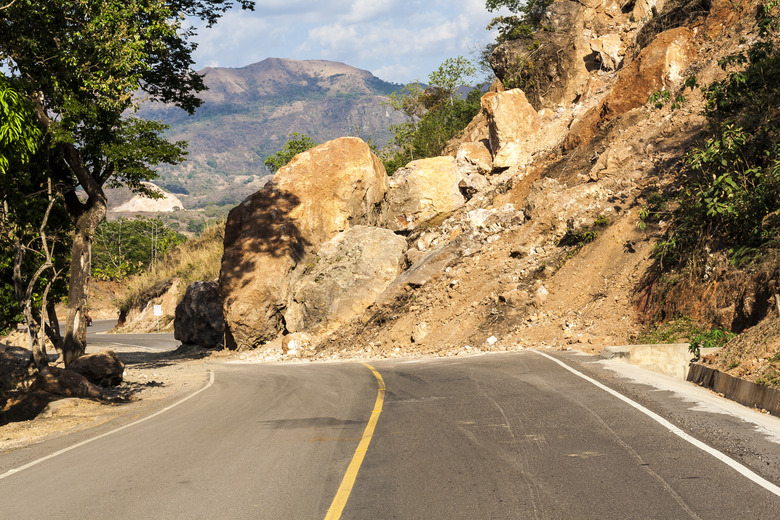How Does Gravity Cause Erosion?
When materials like rocks and soil on the Earth's surface wear down to sand and gravel or move from one location to another, erosion is the main culprit. Landforms, like canyons, often get their shape as a direct result of erosion. Given enough time, water and ice can even cut through solid rock. But the most powerful force behind erosion is gravity. Gravity causes chunks of rock to fall from mountains and pulls glaciers downhill, cutting through solid stone. This kind of erosion — gravitational erosion — shapes the surface of the Earth as we know it.
TL;DR (Too Long; Didn't Read)
Gravitational erosion describes the movement of soil or rock due to the force of gravity. Gravity impacts erosion in direct ways like landslides, mudslides and slump. It can also impact erosion in indirect ways, by pulling rain to the Earth and forcing glaciers downhill.
Gravitational Erosion
Gravitational Erosion
Gravitational erosion represents the movement of soil or rock from one place to another due to gravity's pull. When chunks of stone fall from a mountainside to the ground below, it is because gravity pulled them down. When a glacier moves through a mountain range, slowly flattening or carving the Earth's surface in that area, it is because the pull of gravity forces the glacier downhill. When mudslides or landslides occur, smoothing the sides of mountains or large hills, the gravity is at work.
Even though geologists recognize water and ice as the biggest agents of erosion, it is the force of gravity that powers them both.
Direct Impacts of Gravity
Direct Impacts of Gravity
Gravity impacts erosion in both direct and indirect ways. Direct impacts of the power of gravity include rocks, mud or soil moving downhill. No other agent, such as water or ice, is directly involved in these actions. Instead, gravity works alone to cause erosion.
Landslides often occur as a direct result of gravitational erosion. When soil loosens suddenly, due to another agent, like high winds or earthquakes, rocks and soil tumble downhill because of gravity's power. These materials gather momentum as they fall, causing more soil and rocks to tumble downhill right along with them. Landslides can drastically reshape the sides of hills or mountains any time they occur.
Gravitational erosion can also directly result in mudslides. When mud, formed high atop a hill or mountain, suddenly pulls away to slide downhill, once again the power of gravity is responsible. A mass of moving mud can wash away large amounts of soil as it streams atop soil's surface, and often dislodges rocks and even large boulders. If a mudslide is large enough, it can lead to dramatic, immediate changes in the shape of hills or mountainsides.
Gravity can also directly cause a phenomenon known as slump, in which large chunks of rock and soil suddenly break off and fall from the side of a hill or mountain. Unlike a landslide, rocks and soil no not roll down the side of a such landforms, but instead fall directly to the Earth below. This is how large chunks of mountains and hills can change shape because of slump.
Indirect Impacts of Gravity
Indirect Impacts of Gravity
As two of the best-known agents of erosion, neither water nor ice could cause erosion without gravity's help. Gravity's indirect impacts on erosion include pulling rain to the Earth, drawing floodwaters downward and dragging glaciers downhill.
Rain slowly wears down the surfaces of mountains, hills and other landforms with time, but rain does not reach Earth's surface on its own. Rain forms in clouds when water vapor condenses, and gravity pulls it to Earth. Over time, rain loosens soil and the wind blows it away, or the rain creates mud, which typically moves from the highest to lowest points down the side of a mountain or hill. Rain can also wear rocks down with time, though this process often takes millions of years to drastically reshape large landforms.
Glaciers are some of the most powerful agents of erosion. These giant formations of ice and snow moving across different parts of the Earth at different points in history, continue to do so today. Several million years ago, scientists postulated that glaciers moved across parts of North America, causing major geological changes in what is now the Midwestern United States. Yosemite Valley, located along California's Sierra Nevada mountain range in Yosemite National Park, got its shape when glaciers cut through the range's massive granite, leaving stunning and world-renown features like the sheered off rock-face of Half Dome and the massive El Capitan. Glaciers' slow and steady movement even flattened certain areas in modern-day Indiana with only a few gorges and elevated landforms left intact.
Glaciers move with the help of gravity. Over long periods of time, the pull of gravity forces them toward lower elevations. Glaciers freeze the land around them, then unfreeze a bit, just enough to move further downhill before freezing again. As this process occurs, glaciers break soil and rock apart, pulling them along while often scratching grooves into the bedrock beneath. Because of this, glaciers continually accumulate mass in the form of frozen dirt and rock, making them heavier. Thanks to gravity, the heavier a glacier becomes, the quicker it moves, and the more impact it has upon the land.
Cite This Article
MLA
Cook, Maria. "How Does Gravity Cause Erosion?" sciencing.com, https://www.sciencing.com/how-does-gravity-cause-erosion-13710457/. 23 March 2018.
APA
Cook, Maria. (2018, March 23). How Does Gravity Cause Erosion?. sciencing.com. Retrieved from https://www.sciencing.com/how-does-gravity-cause-erosion-13710457/
Chicago
Cook, Maria. How Does Gravity Cause Erosion? last modified August 30, 2022. https://www.sciencing.com/how-does-gravity-cause-erosion-13710457/
